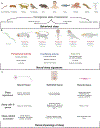Non-REM and REM/paradoxical sleep dynamics across phylogeny
- PMID: 34583217
- PMCID: PMC8719594
- DOI: 10.1016/j.conb.2021.08.004
Non-REM and REM/paradoxical sleep dynamics across phylogeny
Abstract
All animals carefully studied sleep, suggesting that sleep as a behavioral state exists in all animal life. Such evolutionary maintenance of an otherwise vulnerable period of environmental detachment suggests that sleep must be integral in fundamental biological needs. Despite over a century of research, the knowledge of what sleep does at the tissue, cellular or molecular levels remain cursory. Currently, sleep is defined based on behavioral criteria and physiological measures rather than at the cellular or molecular level. Physiologically, sleep has been described as two main states, non-rapid eye moment (NREM) and REM/paradoxical sleep (PS), which are defined in the neocortex by synchronous oscillations and paradoxical wake-like activity, respectively. For decades, these two sleep states were believed to be defining characteristics of only mammalian and avian sleep. Recent work has revealed slow oscillation, silencing, and paradoxical/REM-like activities in reptiles, fish, flies, worms, and cephalopods suggesting that these sleep dynamics and associated physiological states may have emerged early in animal evolution. Here, we discuss these recent developments supporting the conservation of neural dynamics (silencing, oscillation, paradoxical activity) of sleep states across phylogeny.
Copyright © 2021 The Author(s). Published by Elsevier Ltd.. All rights reserved.
Conflict of interest statement
The authors declare they have no conflicting interests.
Figures

References
-
- Anafi RC, Kayser MS & Raizen DM Exploring phylogeny to find the function of sleep. Nat. Rev. Neurosci 20, 109–116 (2019). - PubMed
-
- Tononi G & Cirelli C Sleep function and synaptic homeostasis. Sleep Medicine Reviews vol. 10 49–62 (2006). - PubMed
-
-
Toda H, Williams JA, Gulledge M & Sehgal A A sleep-inducing gene, nemuri, links sleep and immune function in Drosophila. Science (80-. ) 363, 509–515 (2019).
(•) Describes a novel antimicrobial gene that enhances immune function by promoting sleep.
-
Publication types
MeSH terms
Grants and funding
LinkOut - more resources
Full Text Sources

